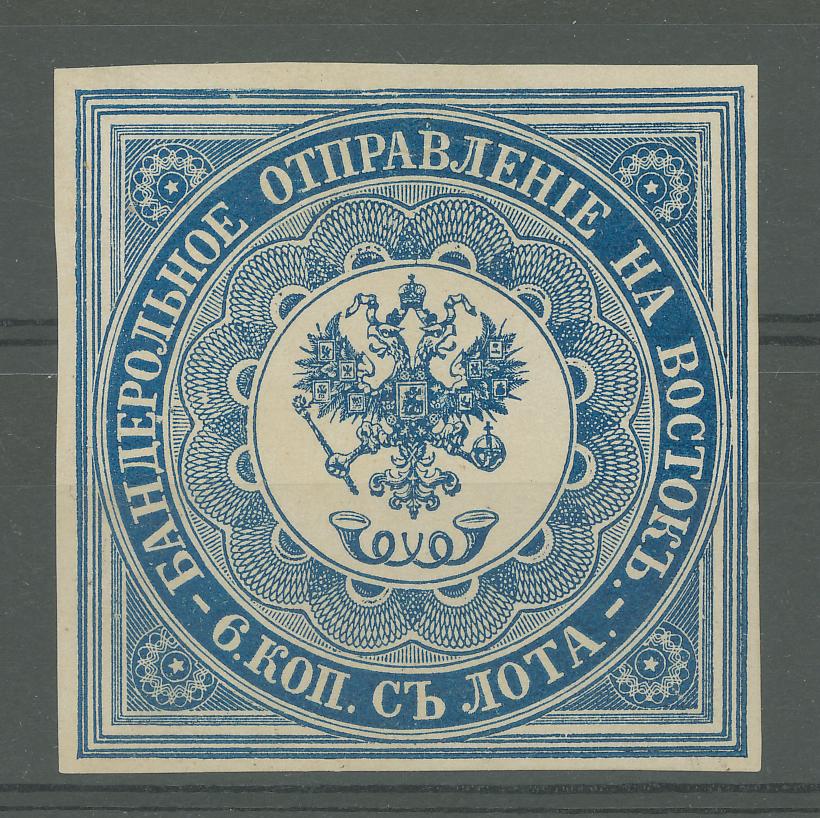
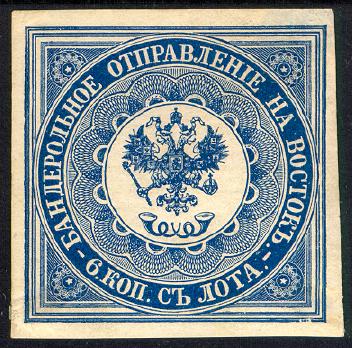
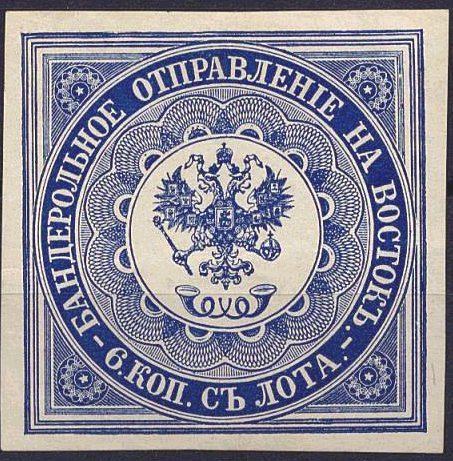
Return To Catalogue - Russian postoffices in Turkey, part 2 - Russian postoffices in Turkey, part 3 - Russia Overview
Note: on my website many of the
pictures can not be seen! They are of course present in the cd's;
contact me if you want to purchase them: evert@klaseboer.com.
6 k blue
These stamps were used on newspapers from Russia to Turkey and vise-versa. They have dimensions 42.5 x 42.5 mm. Specialists distinguish the 1st issue in light blue (printed in sheets of 4 stamps in one row vertically making 4 different types), the 2nd issue in blue (printed in a square of 2x2 stamps with 4 different types) and the 3rd issue in dark blue on thick paper (printed in a square of 2x2 stamps, prepared, but never issued). Type 2 has some white spots in the outer lower right framelines. Type 4 has an oblique scratch below the letters 'OP' of 'KOP'. Proofs exists in dark brown and red (carmine-rose). If I'm well informed, this stamp was used up to 1866.
Value of the stamps |
|||
vc = very common c = common * = not so common ** = uncommon |
*** = very uncommon R = rare RR = very rare RRR = extremely rare |
||
| Value | Unused | Used | Remarks |
| 6 k | RR | RRR | |
Cancels: In the Ferrary auction guide a stamp with a rectangular cancel can be found. I've seen others with circular town cancels (in black or blue).
Forgeries exist of these stamps. Genuine stamps usually have small dots above the small half-moons surrounding the central circle (source: Serrane guide).
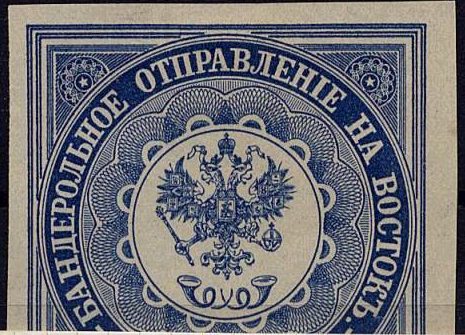
(Forgery, sorry, I only have the upper part of this picture)
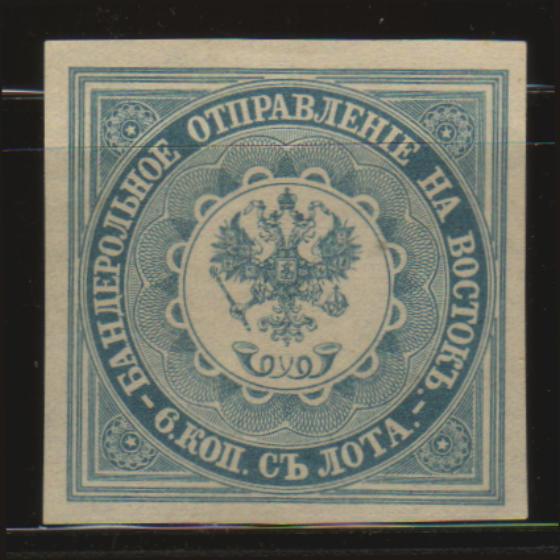
This forger even seems to have imitated two colour shades: blue
and dark blue
![]()
The lines of the second outer frame are too far away from the
central circle on top (zoom-in)
The above forgeries have the crown of the eagle too close to the circle above it, the serifs of the letters are also too big (compare for example the 'HA'). I know that the forger Fournier sold forgeries of this stamp (this is probably his 'first choice' forgery). Also, the lines from the second outer frame (the ones that should almost touch the central circle) are too far away from the central circle on top; clear white spaces can be distinguished. In the Serrane guide, this forgery is identified as the 'Faux de Geneve'.
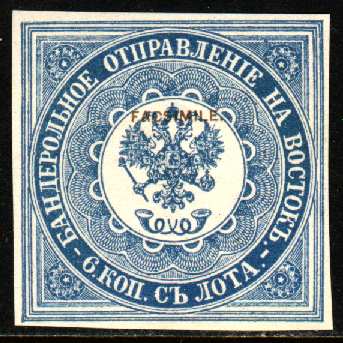
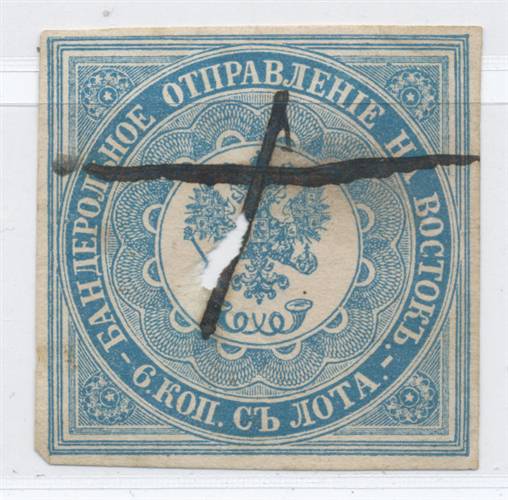
Senf forgeries, with overprint 'FACSIMILE'. On the right hand
side image the word 'FACSIMILE' has been cleverly disguised with
a pencancel.
Senf made a forgery of this stamp. This forgery was distributed with stamp journal the 'Illustrierten Briefmarken Journal', No 24 (17 December 1887) as an 'art supplement' or 'Kunstbeigabe'. The forgery always bears 'FACSIMILE.' on top. Sometimes, this word has been erased or a cancel has been placed on top of it (see image above). Genuine stamps always(?) have some blue dots in the white spaces around the small half-moons surrounding the central circle. This forgery does not have such dots. In the Senf forgeries I've seen there is a blue spot of ink above the last 'E' of 'OTPRAVLENIE' (in the white space just to the left of the upper right star decoration).
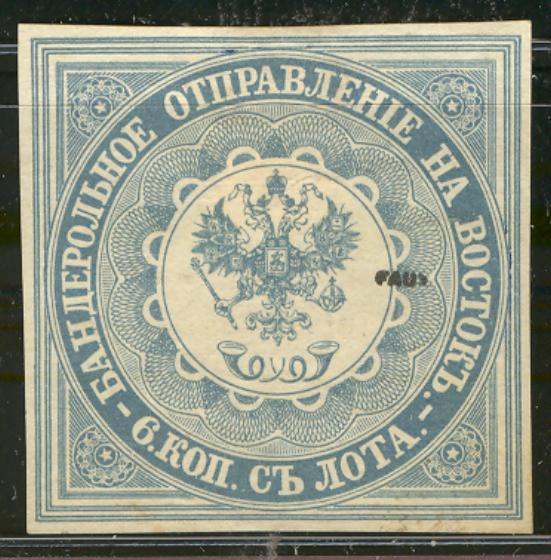
Another forgery with 'FAUX' overprint. Genuine stamps always(?)
have some blue dots in the white spaces around the small
half-moons surrounding the central circle. This forgery does not
have such dots.
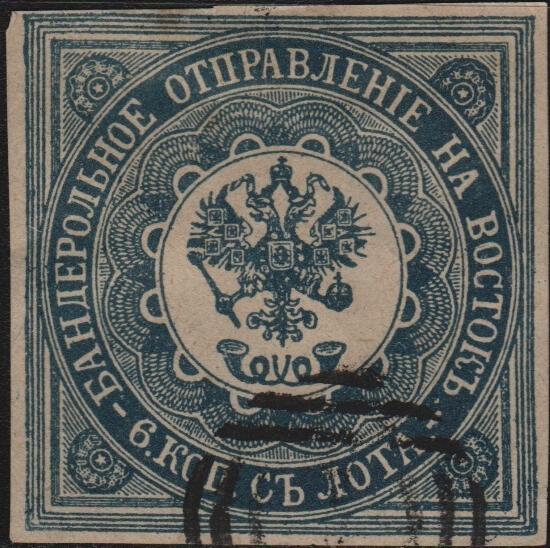
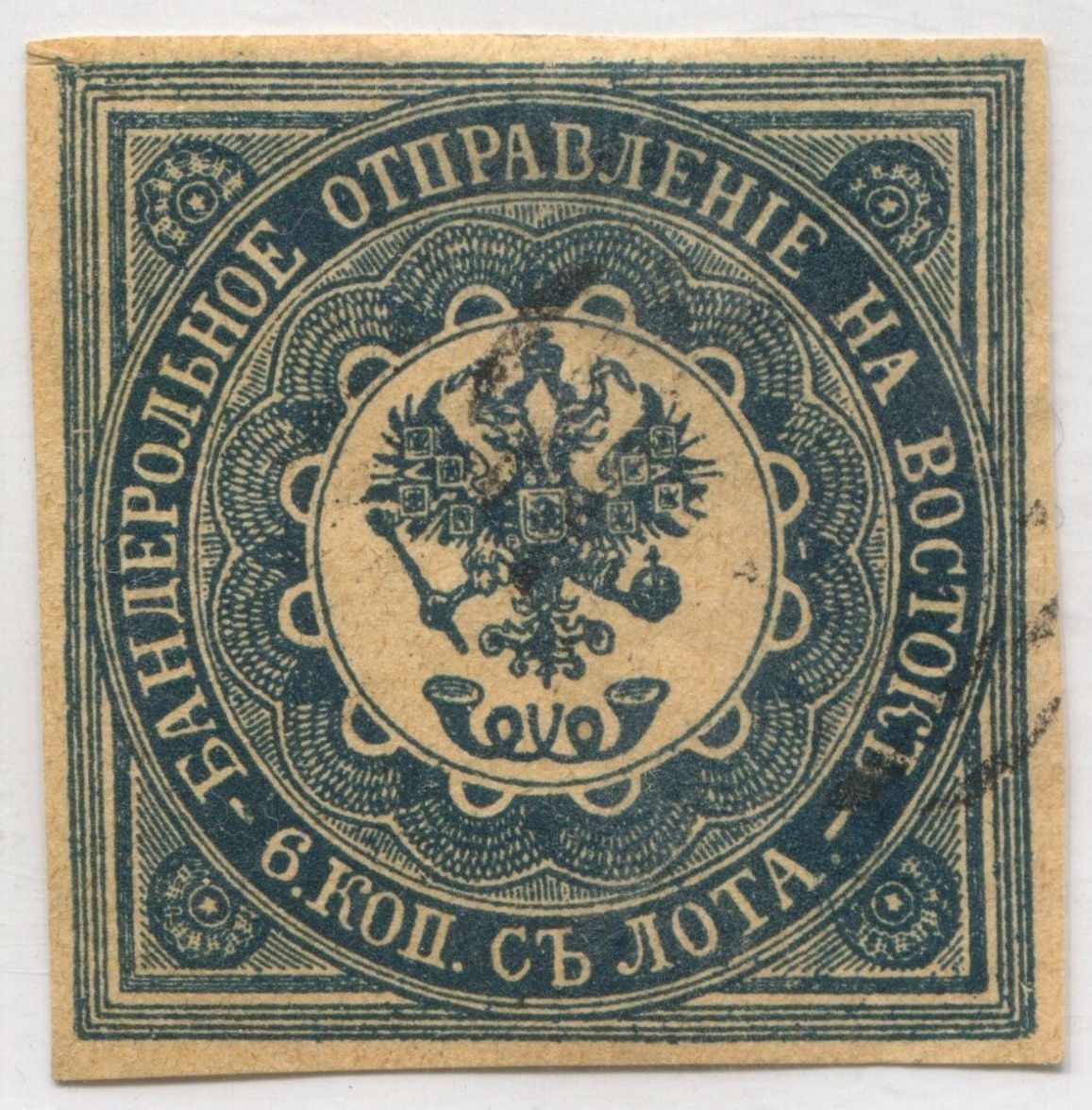
More primitive forgery with the letters not nicely printed (for
example, the '6' appears to slant backwards). I've also seen this
forgery in tete-beche with a numeral '3' dot cancel. The tips of
the wings of the eagle are different, the number of lines in the
corners is different etc. This is possibly the lithographed
forgery "S" mentioned in the Serrane guide, which has
solid small halfmoons around the central circle. Could
"S" be the forger Spiro?
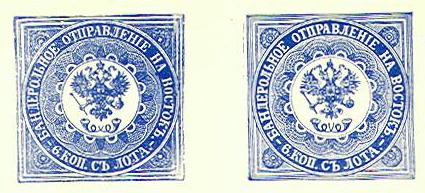
"Epreuves" from a Fournier album (his second choice
forgeries?). Reduced size, two different types.
I know that the forger Fournier sold forgeries of this stamp (the next image probably shows one of his 'second choice' forgeries). The following forgery has the crown touching the circle above it, the posthorns are placed too low. The ondulating patterns around the central circle are not similar to the genuine stamp (especially noticable in the overlapping areas, where they should form seme-circles in the genuine stamps). I've seen a similar forgery (but then in dark-blue) in a Fournier Album on the pages "Epreuves des cliches dont les timbres n'existent plus au stock" (proofs of stamps for which stamps were not available, see image above). The defects on the right hand side (lines in the upper right side and white spaces in the lower right side) are similar to the stamp shown below:
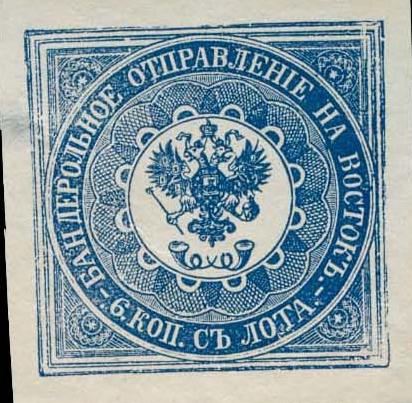
Fournier forgery, corresponding to the image on the left of the
'Epreuves' shown above
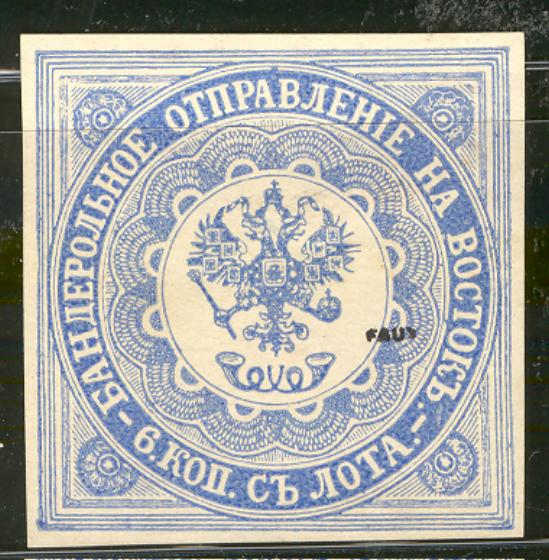
Another Fournier forgery with 'FAUX' overprint, the Russian 'L'
of 'OTPRAVLENIE' doesn't have the correct left foot, the 'V' (B)
of this word is not slanting to the right and the 'A' doesn't
have a bottom left serif. The stars in the four corners are badly
done. In the forgeries of this type I've seen, the wings of the
eagle are different from the genuine stamp, the half-circle
patterns are not so nicely done as in the genuine stamp. There is
also a blue ink blob just above the 'A' of 'OTPRAVLENIE'. This
forgery corresponds to the right 'Epreuve' of the Fournier album
shown above.
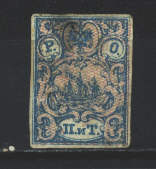
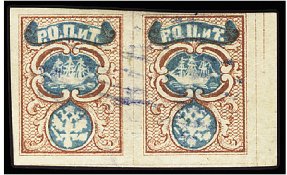
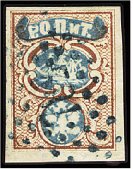
(Reduced sizes)
(10) pa blue and brown (2) Pi red and blue (10) pa red with blue underprint (10) pa red with blue underprint (ship and eagle no lines) (2) Pi blue with red underprint (2) Pi blue with blue underprint (ship and eagle no lines)
Value of the stamps |
|||
vc = very common c = common * = not so common ** = uncommon |
*** = very uncommon R = rare RR = very rare RRR = extremely rare |
||
| Value | Unused | Used | Remarks |
| 10 pa blue and brown | RRR | RRR | Size 15 1/2 x 21 mm; printed in sheets of 28 (7x4) giving rise to 28 types. |
| 2 Pi red and blue | RRR | RRR | Size 15 1/2 x 21 mm; printed in sheets of 28 (7x4) giving rise to 28 types. |
| With lined (horizontal) network underprint | |||
| 10 pa red | *** | *** | Size 16 x 21 1/2 mm |
| 2 Pi blue | R | R | Size 16 x 21 1/2 mm |
| With lined (vertical) network underprint (eagle and value no lines) | |||
| 10 pa red | RR | RR | |
| 2 Pi blue | RR | RR | |
On letter:
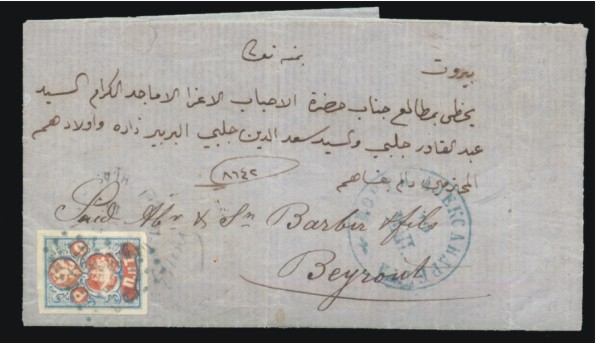
The inscription 'P.O.P.n.T' stands for: 'Russkoe Obshchestvo Parokhodstva I Torgovli' which means: 'Russian Company for Steam Shipping and Trade' in Russian. There was an agreement between the Russian govenment and this company to use the offices of the company as postal offices in Turkey. These stamps had no value indicated on them.
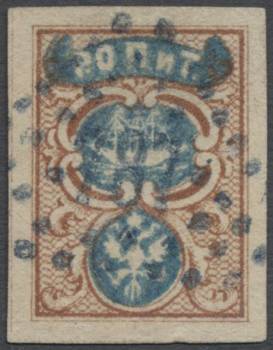
Stamp with a typical dots cancel; '787' in this case (Saloniki)
Some of the triangular numeral dots cancels used on these stamps (usually applied in blue ink): 777 (Batum), 778 (Trebizonde), 779 (Mytilene), 780 (Smyrna), 781 (Merson), 782 (Alexandrette), 783 (Beirut), 784 (Jaffa), 785 (Alexandria), 787 (Saloniki) etc.
Reprints seem to exist of all these stamps (slightly different colours and papers).


Reprints, they are quite far apart
I've been told that the above stamps are official
reprints, however in the book 'The forged Stamps of all
Countries' by J.Dorn, it is mentioned that they are unauthorised
reprints. There is an very large margin between two stamps.
According to 'Russian post in the Empire, Turkey, China and the
post in the kingdom of Poland' by S.V.Prigara; the reprints were
made around 1875 (all values, except the 10 pa vertical network
underprint) and again in 1892 (all 6 values). It is mentioned
there that the second color was printed with new (altered)
stones. Pictures of reprints of 1892 and original stamps can be
found in 'The London Philatelist' of 1906 (page 215); but the
images are not very clear.... It is stated that 350 reprints were
made.
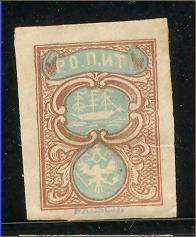
Senf forgery, with inscription 'FALSCH'
at the bottom; the ship design is different from the genuine
stamps and the letters are too thin.
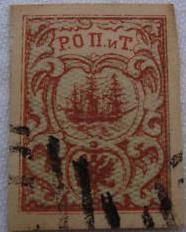
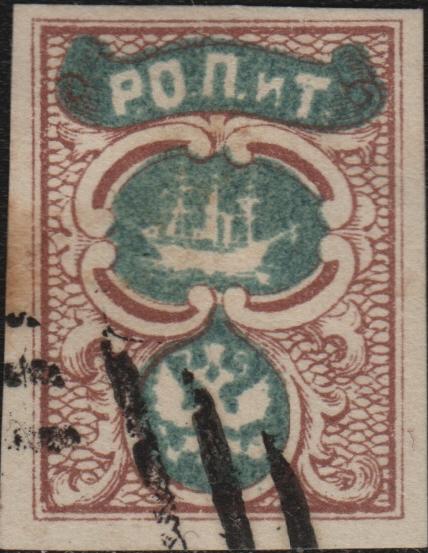
Left: forgery (possibly of Italian origin). Next to it a forgery
probably made by the same forger (judging from the cancel).
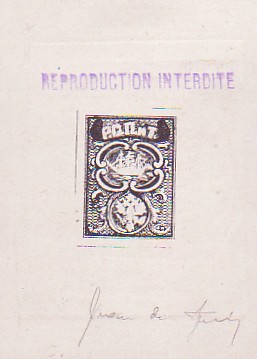
Forgery made by the forger Sperati: 'proof' in black
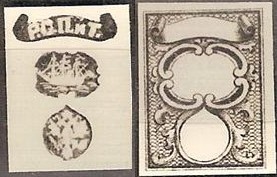
Another black 'proof' of made by Sperati, showing the two parts
of this stamp.
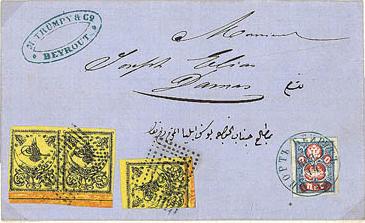
Michael Zareski forged letter. Zareski was a forger from Paris
who was active in the 1960's. The Russian Levant stamp was added
to this letter by him.
1 k brown 1 k orange (1884) 1 k black and yellow (1879) 2 k black and red (1879) 2 k green (1884) 3 k green 5 k blue 5 k lilac (1884) 7 k red and grey (1879) 7 k blue (1884) 10 k red and green Surcharged
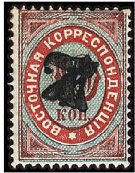
(Reduced size)
'7' on 10 k red and green (1879) '8' on 10 k red and green (1876)
The size of these stamps is 16 1/2 x 22 1/2 mm.
Value of the stamps |
|||
vc = very common c = common * = not so common ** = uncommon |
*** = very uncommon R = rare RR = very rare RRR = extremely rare |
||
| Value | Unused | Used | Remarks |
| Watermark 'Wavy lines', perforated 11 1/2 (1868) | |||
| 1 k brown | *** | *** | |
| 3 k | *** | *** | |
| 5 k blue | *** | *** | |
| 10 k | *** | *** | |
| Watermark 'Wavy
lines', perforated 14 1/2 Horizontally or vertically laid paper (1872) |
|||
| 1 k brown | *** | * | Vertically laid paper: *** |
| 1 k black and yellow | * | * | Vertically laid paper: ** |
| 2 k black and red | ** | ** | Vertically laid paper: *** |
| 3 k | *** | * | Vertically laid paper: *** |
| 5 k blue | * | * | Vertically laid paper: *** |
| 7 k red and black | ** | * | Vertically laid paper: *** |
| 10 k | * | * | Vertically laid paper: R |
| 7 on 10 k | R | R | Surcharge in black or blue '7' fat (R) or thin (RRR) |
| 8 on 10 k | R | R | Surcharge in black or blue. |
| Perforated 14 1/2 (1884); one color only | |||
| 1 k yellow | c | c | |
| 2 k green | c | c | |
| 5 k lilac | * | * | |
| 7 k blue | * | c | |
Proofs in other colors exists of the 1 and 10 kop values of the 1868 issue. Also a 3 k red imperforate exists (prepared, but not issued). Source: 'Russian post in the Empire, Turkey, China and the post in the kingdom of Poland' by S.V.Prigara. Other imperforate stamps are also proofs.
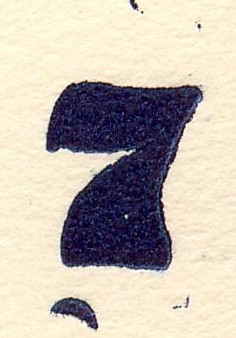
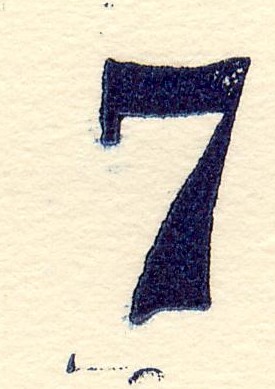
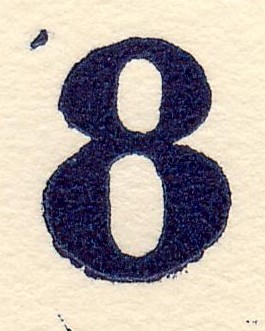
Forged surcharges made by the forger Fournier as they can be
found in 'The Fournier Album of Philatelic Forgeries'
The surcharged stamps were extensively forged. All surcharges on the stamps with perforation 11 1/2 are forgeries.